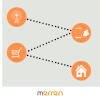If you want to understand your audience better, then open-ended questions are the way to go. Open-ended questions allow individuals to express their thoughts, feelings, and experiences in their own words. In this blog post, we’ll explore what open-ended questions are and how they can unleash the power of qualitative data. We will delve into how to analyze responses from open-ended questions and create actionable insights that can help move your business forward.
What are Open-Ended Questions?
Open-ended questions are those that offer a broad range of answers and encourage detailed responses, as opposed to closed-ended questions with limited or numeric options. They play a crucial role in qualitative research, collecting rich data on people’s experiences, attitudes, and beliefs. Researchers use them to gain deeper insights and make informed decisions.
The power of qualitative data
Qualitative research is a great way to gain valuable insight into your audience. By using open-ended questions, you can encourage critical thinking and longer responses that provide you with additional information. Examples of open-ended questions include “Tell me about your experience with our product” or “What do you think could be improved about our customer service?”. These types of questions are a good way to get valuable information from your questioner without receiving a single-word answer or closed question.

Advantages of Open-Ended Questions
Open-ended questions encourage elaborate and critical thinking, bringing longer responses that yield qualitative data. By contrast, closed-ended questions with one-word answers or multiple-choice options limit response rates and provide little additional information. Here are some of the advantages marketers can note while collecting data.
Understand your audience
Understanding your audience is crucial for any business. The main aim is to obtain information about the user’s preferences, behaviours and why they prefer a certain benchmark. Giving options to share opinions also allows users to share their testimonials, grievances and why they rated a certain scale with a particular number. Seeking response goes beyond the numbers.
Encouraging detailed responses
Sometimes, a numerical metric may not denote much beyond a certain rating or a satisfaction scale. To collect detailed responses ,you have to offer an open section where customers can share the rating and explain why they put in a certain rating. By encouraging detailed responses, you’ll gain additional insight and uncover unexpected perspectives. Open-ended questions are an excellent tool for exploring new topics. People can share certain keywords that can help you curate better strategies as an upgrade.
Curating Effective Open-Ended Questions
Here are some valuable guidelines that you can use when you build a customer survey. The end goal of the survey is also to collect candid feedback or constructive criticism along the touchpoints.
Using clear and concise language
When seeking open feedback, focus on clearly asking for a candid response. Avoid using closed questions or leading phrases, as these may encourage one-word answers or restrict critical thinking. Keep the answer space directly pertaining to the question you ask. For example “Share your reason for the rating:”. The power of qualitative data lies with the opinions of the respondents.
Avoiding leading questions
Leading question is based on a direct implication. It is important to avoid this error since that may cause bias and produce skewed results. Use neutral and non-judgmental wording when asking participants to “describe” or “tell me about” their experiences. Avoid jargon and keep the question to the point. For example “Did you like our detailed services?” would prompt the respondent into a ‘yes or no’ type of an answer. A better way to frame it would be- “how would you rate our services?”- provided with a scale and a space for them to explain their stance on the rating.
Best Practices For Creating Open-Ended Questions
While building a survey, it is important to create every question with equal clarity, keep it goal oriented and achieve survey completion. Even when we seek opinion based answers from our respondents, it is still very important to adhere to the guidelines so that the responses we get are free of bias. Here are some best practices to adopt while soliciting open-ended questions:
Keep direct questions
Direct questions are clear, to the point and mostly jargon free. This means that the question is seeking an answer that will satisfy the purpose of the question. At this point, it is crucial to avoid leading questions and double baralled questions. Simple language will solicit a greater number of responses and you can collect authentic qualitative data.

Provide context to gain information
Open-ended is mostly used when you seek opinions. This can be a following question after a certain rating metric such as net promoter score, CSAT score or even in-app feedback review. The metric based questions provide a context for the respondent to share details on their rating. This is also a call to seek a review, criticism or a testimonial. This format is mostly used within applications, websites and email survey forms.
Use open-ended prompts
Open-ended prompts can be used to encourage respondents to share more information. For example, instead of asking “Did you have a good experience with our customer service?” you could ask “Can you tell us about your experience with our customer service?”. This allows the respondent to share details and provide a richer response.
Offer space for elaborate answers
Short answer boxes may discourage them from providing thorough answers. Gauge the type of question asked and provide ample space for opinion based response. This will give you more data on the customer’s perspective, their pain points or their satisfaction metric at a customer journey touchpoint. Qualitative data is a powerful tool to comprehend your user base and what they feel about your product and service offerings.
Analyze Responses to Open-Ended Questions
To analyze open based answers, choose a software that can segregate responses based on ratings and opinions. Merren can segregate responses based on certain keyterms or keywords. The words are collectively put into a word cloud. In this manner, you can view certain repetitive words, emotions, mostly used terms by respondents to help you gauge patterns.
Coding and categorization
Begin by categorizing and coding the responses into significant groupings. Identify prevalent themes, concepts, or subjects that arise from the information. Allocate corresponding labels or codes to every response based on their respective categories. This aids in organizing the data and simplifies comparison and explanation.
Creating actionable insights
Categorizing the data involves identifying common patterns in the analysis process. With these findings, you can comprehend common patterns . Communicating this information is critical via multiple-choice questions or visual aids like charts or graphs. Extremes of emotions can help you understand if consumers are unhappy at a certain touchpoints. For example, the rating for a product could be marked as ‘good’ but respondents might also want to add a critical point to note.

Manual reading and reflection
It is imperative to go through each response with careful attention and manually assess the qualitative data. While doing so, be mindful of any subtle nuances, underlying emotions, or implicit messages that may not be immediately visible. Take note of the tone, language employed, and the overall context of the response. By conducting a thorough reading, you can gain valuable insights that go beyond surface-level observations.
Conclusion
Open-ended questions are a powerful tool for collecting qualitative data. They allow you to tap into the thoughts, experiences of your audience in a way that closed-ended questions cannot . By understanding your audience and encouraging detailed responses, you can gain valuable insights that can help shape your business strategy and decision-making.
Using Merren, you can opt for customized templates to help you build your own survey. Use our vivid charting facilities to segment your qualitative data into actionable insights. Bring insights at a superfast speed today. Try our features and sign up for a 14 day free trial and 10X your response rate.





